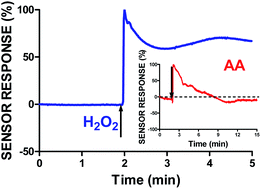In vitro physiological performance factors of a catalase-based biosensor for real-time electrochemical detection of brain hydrogen peroxide in freely-moving animals†
Abstract
Physiological performance factors of a catalase-based paired microelectrochemical biosensor, developed for real-time neurochemical monitoring of hydrogen peroxide (H2O2), were determined in the in vitro environment. The excellent ascorbic acid (AA) rejection characteristics and high sensitivity of the paired H2O2 sensor were assessed and verified. The highly suitable response time of the H2O2 sensor was demonstrated and the limit of detection of this sensor was calculated as ca. 0.075 μM. The H2O2 sensor was selective over the electroactive substance Mercaptosuccinate which is used in vivo to disrupt the enzymatic degradation of brain H2O2. The H2O2 sensing element of this paired design was impervious to an acidic/basic shift in environmental pH (6.5/8.0) relative to physiological levels (7.4). The influence of a temperature transition (ca. 23 °C to 37 °C) and a physiological temperature fluctuation expected to be found in vivo (1–4 °C), on the response of the paired H2O2 sensor was deemed negligible and consistent with other amperometric methods. The enzymatic component of the paired H2O2 sensor was found to be stable over a 14 day period of continuous ex vivo brain tissue exposure.



 Please wait while we load your content...
Please wait while we load your content...